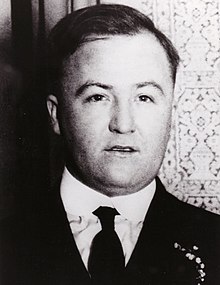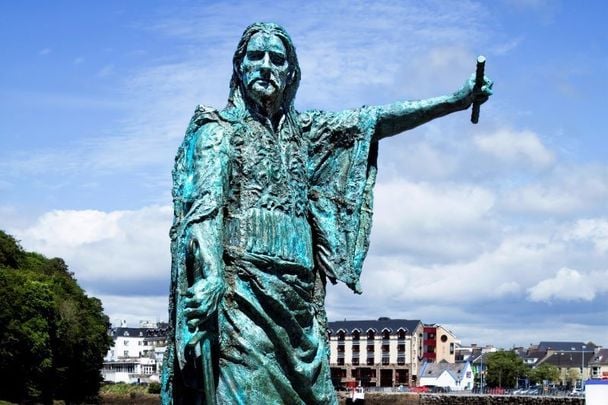
In the violent symphony of Prohibition-era Chicago, Dean O’Banion was no mere player—he was the conductor, orchestrating his own bloody piece against the city’s infamous Italian Mafia. O’Banion, a florist by day and a gangster by night, wasn’t just another Irish-American crime boss; he was a man of contradictions. A churchgoing devout Catholic with a taste for power, a charming joker with a penchant for savagery, O’Banion was as complex as the streets he ruled.
His rise to power was as audacious as his reign was chaotic. He took on Al Capone and the Chicago Outfit, establishing himself as one of the most influential figures in the history of organized crime—before it all came crashing down in a hail of bullets. This is the story of Dean O’Banion, a gangster who played by his own rules and paid the ultimate price.
👉 Discover the untamed legacy of Vincent “Mad Dog” Coll at Secret Ireland.
👉 Explore the legacy of Bugs Moran, O’Banion’s successor, at Secret Ireland.
👉 Learn more about Irish-American gangsters like Jimmy Coonan at Secret Ireland.
Hellraiser from the Start
Born in 1892 to Irish immigrants in Aurora, Illinois, Charles Dean O’Banion grew up in a world where survival was a daily fight. He moved to Chicago’s North Side as a young boy, cutting his teeth in the crime-ridden streets of Little Hell, a neighborhood as fiery as its name suggested. By his teens, O’Banion was already running with a gang, pulling off petty thefts and burglaries while honing his skills as a street fighter.
What set O’Banion apart wasn’t just his brawn—it was his charisma. He had a grin that could disarm an enemy and a wit as sharp as his knife. These traits would serve him well as he climbed the ladder of Chicago’s criminal underworld.
The North Side Gang: Building an Empire
In the early 1920s, as Prohibition turned booze into gold, O’Banion saw his opportunity. Together with his childhood friends Hymie Weiss, Vincent Drucci, and George “Bugs” Moran, O’Banion founded the North Side Gang, a group that would become synonymous with Irish-American organized crime in Chicago.
Under O’Banion’s leadership, the North Side Gang built a thriving empire. They controlled speakeasies, breweries, and bootlegging operations, funneling illegal liquor to a thirsty city. O’Banion’s charm and business savvy earned him connections with politicians and police, allowing him to operate with relative impunity.
But O’Banion wasn’t just a businessman—he was a showman. By day, he ran a flower shop in downtown Chicago, serving high-profile clients, including gangsters and politicians. The shop became a front for his criminal activities, a place where deals were made, and scores were settled.
👉 Explore more about Irish-American gangsters at Secret Ireland.
A Bloody Feud with the Chicago Outfit
O’Banion’s success inevitably brought him into conflict with the Chicago Outfit, the powerful Italian-American mob led by Johnny Torrio and Al Capone. What started as a tense business rivalry quickly escalated into open warfare. O’Banion refused to bow to the Outfit’s demands, often using his sharp tongue to mock Torrio and Capone, further inflaming tensions.
The feud reached its boiling point in 1924 when O’Banion double-crossed Torrio in a deal that left the Italian mob boss humiliated and out $500,000. Torrio retaliated, but O’Banion struck back harder, targeting the Outfit’s operations with relentless attacks. For O’Banion, the war wasn’t just about power—it was personal.
The Assassination of Dean O’Banion
On November 10, 1924, the war between the North Side Gang and the Chicago Outfit came to a head. O’Banion was tending to his flower shop when three gunmen entered, posing as customers. As O’Banion extended his hand for a shake, they opened fire, killing him instantly. The assassination, ordered by Torrio and carried out by Capone’s men, was one of the first major hits in Chicago’s bloody gangland history.
O’Banion’s death was a turning point. It unleashed a wave of retaliatory violence that plunged Chicago into years of brutal gang wars. His successors, including Bugs Moran, continued the fight, but none could match O’Banion’s charisma or audacity.
👉 Learn about Bugs Moran’s defiance against Capone at Secret Ireland.
The Legacy of Dean O’Banion
Dean O’Banion’s life was short, but his impact was profound. He wasn’t just a gangster—he was a trailblazer who helped define the era of organized crime. His leadership of the North Side Gang established a blueprint for Irish-American organized crime that would be echoed by figures like Vincent “Mad Dog” Coll and Jimmy Coonan.
But O’Banion’s legacy isn’t just about crime—it’s about defiance. He stood against the might of the Chicago Outfit, refusing to back down even when the odds were against him. In a world dominated by larger-than-life figures like Al Capone, O’Banion’s story remains a testament to the spirit of Irish resilience.
👉 Explore Vincent Coll’s untamed legacy at Secret Ireland.
What Dean O’Banion Teaches Us About Power
O’Banion’s rise and fall highlight the fragility of power in the criminal underworld. His charisma and audacity brought him to the top, but his unwillingness to compromise sealed his fate. Yet, it’s precisely this defiance that makes his story so enduring. O’Banion wasn’t just a gangster—he was a fighter, a showman, and a man who refused to kneel.
The Irish-American Gangster Legacy
From Dean O’Banion’s flower shop to the chaotic reign of Vincent Coll, the story of Irish-American gangsters is one of grit, ambition, and unrelenting spirit. These figures weren’t just criminals—they were products of their environment, shaped by the struggles and resilience of their Irish heritage.
👉 Learn more about Irish-American gangsters and their legacies at Secret Ireland.
Sláinte to the showmen, the rebels, and the fighters who dared to make their mark in a brutal world.





5 thoughts on “Dean O’Banion: The Irish-American Gangster Who Took on the Chicago Outfit”
Comments are closed.